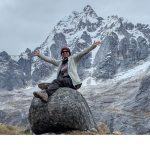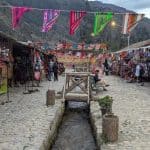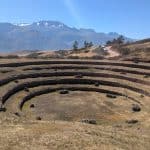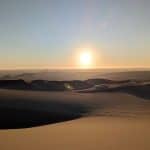Sucre: Two Days Inca Trail Hike To Maragua Crater
We have been slowly traveling across Bolivia. We spent 3 weeks in the beautiful Sucre. If you’re in Sucre and craving an adventure that mixes ancient history, raw landscapes, and a humbling peek into rural Bolivian life – Camino del Inca is it. This two-day trek took us to the Maragua Crater, Niñu Mayu, and Potolo following centuries-old trails through rocky ridges, hidden valleys, and right into a crater that looks like it belongs on another planet.

While most travelers head to the popular dinosaur park near Sucre to glimpse fossilized footprints, this route takes you to Niñu Mayu – a far less touristy spot where you can see real dinosaur tracks up close, all while surrounded by jaw-dropping scenery and colorful mountains. We faced steep climbs, narrow cliffside paths, sore legs, and even a few unexpected surprises. But the payoff? Pure magic.
Preparing For The Hike
We booked our trek with Green Trekkers in Sucre after reading some solid reviews online. At their office, we met Pablo and his wife – both super welcoming and helpful. Pablo walked us through the entire plan in detail, patiently answering all our questions, which made us feel confident about the two-day route. The plan was to hike the Inca Trail from Chataquila to the stunning Maragua Crater on Day 1, and then continue on to Niñu Mayu and Potolo on Day 2, before heading back to Sucre. It felt good to have clarity and a local guide for this journey, especially since some sections of the trail are not well-marked.
You can also book the tour with Jalq’a Tours who are equally amazing.
Camino Del Inca Hike Details
Distance and Time I 35 km , 16-18 hours
Difficulty I Moderate to Difficult
Sites To Visit I Chataquila, Maragua Crater, Niñu Mayu and Potolo
What to expect I You will walk on the original Inca Trail and go to the Maragua crater to spend a night, see the dinosaur footprints, go through valleys, small villages and roads. There will be some steeper sections and downhill sections too.
DAY 1: Maragua Crater via Inca Trail
Day 1 kicked off with excitement and a bit of nervous energy – we were finally heading into the Andes for the real adventure. From Sucre to Chataquila, and then down the ancient Inca Trail, the day unfolded with dramatic scenery, steep descents, and unexpected challenges.
Hike Details – Day 1
Distance and Time I 17-20 km , 6-8 hours
Difficulty I Moderate to Difficult
Highest Altitude I Chataquila 3600m
Sites To Visit I Chataquila, Inca Trail, Chaunaca, Socapampa, and Maragua Crater
What to expect I You will walk on the original Inca Trail and go to the Maragua crater to spend a night. You will pass by small villages. Expect constant downhills and uphill sections.
We arrived at the Green Trekkers office around 8:30 AM, just the two of us. Our guide for the trek was Rene, and before we set off, Pablo handed us 2 liters of water each and offered us hiking poles – which we were very grateful for later. After a smooth one-hour drive in a comfortable car, we reached Chataquila, the starting point of the Inca Trail, sitting at an altitude of 3,600 meters.
The First Part
The Inca Trail itself is a 5 km stretch – rocky, uneven, and mostly downhill. Since it was a Saturday, we saw many hikers along the way, most of them doing the popular one-day version of the hike. We took our time, soaking in the panoramic views of the mountains, walking slowly, and just enjoying the experience.

Though it wasn’t all easy for me. I had just gotten my period and was struggling through pain and fatigue, but I was determined to push through! Also cursing myself why I had to choose this day to do the hike. Meanwhile, Zohaib kept cheering me!
After about 2.5 hours, we finished the Inca Trail section and stopped for lunch. Rene had packed pasta with quinoa and a veggie patty, along with bananas for snack. We had our lunch at a small shaded hut right when the Inca trail section ends.
The Second Part
The second stretch was a 2-hour walk on a gravel road, mostly downhill. This was the easiest part of the day – gentle on the legs and mentally relaxing. It got a little cloudy which gave us relief from the sun. But that calm was short-lived.
The Third Part
The final stretch to Maragua Crater was anything but easy. It was a 2-hour uphill climb that started off from a suspension bridge, winding through forested areas and then opening up into a wide valley. The trail here wasn’t marked, and according to our guide, many people get lost in this section if they don’t know the route.

One of the most intense parts came when we faced a series of sketchy, narrow paths on sandy slopes. There was no real trail – just loose earth slipping under our shoes, a steep drop on one side, and nothing to hold on to. I had to grab Rene’s hand because I was drained from the pain and honestly scared out of my mind. And just when I thought it was over, he told us there were two more of those crossings ahead. By the third one, my legs were shaking, and I was praying with everything I had. Somehow, we made it through.

After almost 8 hours on foot and roughly 20 km of hiking, we finally reached Maragua Crater – and it was breathtaking! Surrounded by colorful mountains and tucked in a peaceful valley, it looked surreal. The sun was setting, the moon was rising, and everything was bathed in soft golden light. Our hostel was right in the middle of the crater, a cozy little place with comfy beds and a hot shower – exactly what we needed after such a tough day.
Ending The Day
To wind down, Rene brewed some cedrón tea with leaves we had collected earlier, and served it with some delicious cookies. He also cooked a warm, hearty dinner – pollo picante with rice and a vegetable soup. After eating, we could barely keep our eyes open. Exhausted but happy, we took a quick shower and were fast asleep by 9 PM.
DAY 2: Niñu Mayu to Potolo
After a deep and much-needed sleep in the heart of the Maragua Crater, we woke up to a peaceful morning surrounded by red and green mountains. Day 2 was supposed to be an easier trek – shorter and less intense. Our legs were sore from the previous day’s climb. Still, the excitement of dinosaur footprints, quiet valleys, and rural Bolivian life was high!
Hike Details – Day 2
Distance and Time I 17-20 km , 6-8 hours
Difficulty I Easy to Moderate
Highest Altitude I Niñu Mayu (dinosaur footprints) 3200m
Sites To Visit I Niñu Mayu, small villages, Potolo
What to expect I You will walk up to the Niñu Mayu from Maragua crater to see the dinosaur footprints, then some downhill section to open meadows, and then flat road to reach Potolo. You will take a bus back to Sucre from Potolo.
After a restful night in the quiet of Maragua Crater, we woke up early to the gentle light of dawn painting the surrounding hills. Somewhere nearby, a rooster was already ‘cookroocooing’, breaking the morning silence.
My period pain had eased, but my legs were sore – every step from the bed reminded me of the steep climbs from the day before. Thankfully, today was meant to be easier. We had our breakfast at 6:30 am: eggs, bread, a slice of cake, and coffee – simple and satisfying.
The First Part
The first stretch was an uphill walk out of the crater towards Niñu Mayu, home to ancient dinosaur footprints. Gaining altitude from around 3,060m to 3,200m, the ascent was gradual and mostly followed a road that curved gently through the mountains. We left behind the colorful layers of the crater, and after about two hours, transitioned into a trail that descended toward a small rural community. The path wound through rocky terrain, and eventually we reached the fossil site – Niñu Mayu.

Seeing the dinosaur footprints in person was unbelievable!! Massive and perfectly preserved, they were a portal to prehistoric times. Strangely, a group ahead of us barely stayed a minute – they likely thought it was off-limits. But since we were with our guide, we got to walk right up to them, take photos, and learn about the species that once walked this land when it was a coastal bed. Two major footprints were from a herbivore and a carnivore dinosaur.
The Second Part
After soaking in the magic of Niñu Mayu, we continued uphill for another 30–45 minutes on a narrow trail before hitting the road to Potolo. This final stretch was a mix of wide-open meadows, quiet grasslands, and scenes of rural life – women herding sheeps, bulls resting under trees, pigs and baby piglets in their enclosed spaces. We passed farms growing corn, peas, and potatoes, and even found what looked like a pig’s jaw fossil on the way.

Around noon, we stopped for lunch under some shade. Rene had prepared vegetable rice, avocados, tuna, and apples! After walking another couple of hours, we reached Potolo around 2:30 pm.
Surprises Ahead
The plan was to catch a minibus back to Sucre in time for our night bus to Cochabamba. But this is Bolivia – timing is never guaranteed. The first minibus was packed with sacks of corn, no room for passengers. The next was full. Another had no fuel. By 4 pm, panic started to creep in as we imagined missing our connection. Just when things felt tight, a large bus rolled in, miraculously empty. Everyone got a seat, and we were on our way.
We arrived at the outskirts of Sucre around 6:30 pm, and thankfully, Green Trekkers sent their van to pick us up and drop us home as they knew we had a night bus to catch for Cochabamba! Rene was managing all the communications in the bus, and we were grateful about it.
By the end of those two days, we had hiked nearly 50 kilometers. My body was wrecked, my legs sore beyond words – but my heart was full. We had crossed Inca paths, steep cliffs, quiet forests, open meadows, and literal time – into the age of dinosaurs. And through it all, we met locals walking barefoot or in sandals, carrying their produce across valleys to sell in Sucre. Their strength and resilience stayed with me, reminding me how much privilege I carried just to be there. To hike, to explore, to feel awe – and then to rest.
Final Thoughts About The Inca Trail Hike
This was my first ever multi-day hike, and what an unforgettable experience it turned out to be. From ancient Inca trails and dinosaur footprints to colorful mountains and open meadows, every step felt like walking through a living history book.
The journey tested our bodies, especially mine on day one, but it also filled our hearts with awe and gratitude. There’s something magical about moving slowly through landscapes that have existed for millennia – it reminds you of your own smallness, but also of your strength.
If you’re considering this trek – do it. Let nature challenge you, humble you, and heal you. You don’t need to be the fastest or the fittest. You just need to keep walking – one step, one breath, one mountain at a time.

READY TO TRAVEL LIKE A LOCAL?
Book a free 30-minute consulting call with us and let’s start planning your next unforgettable adventure!






